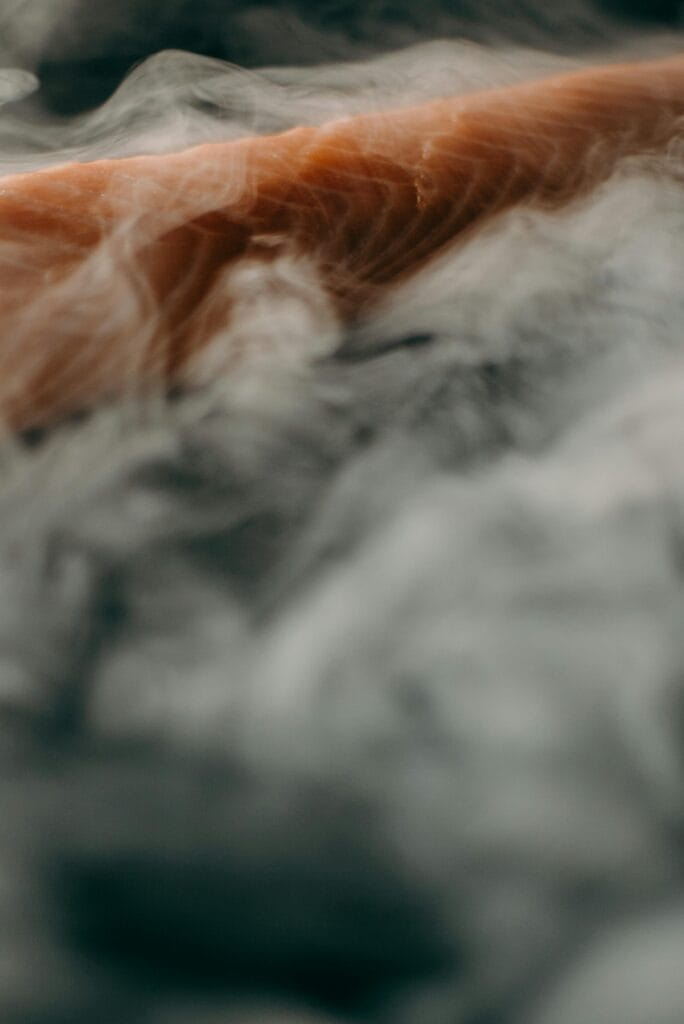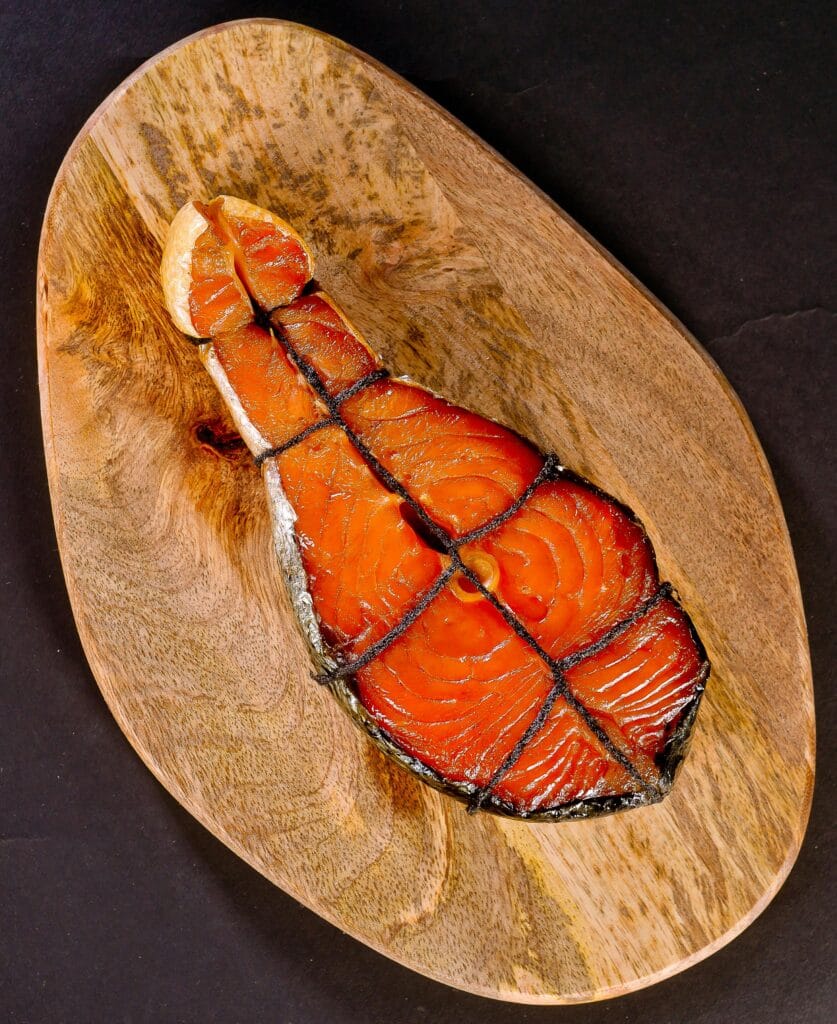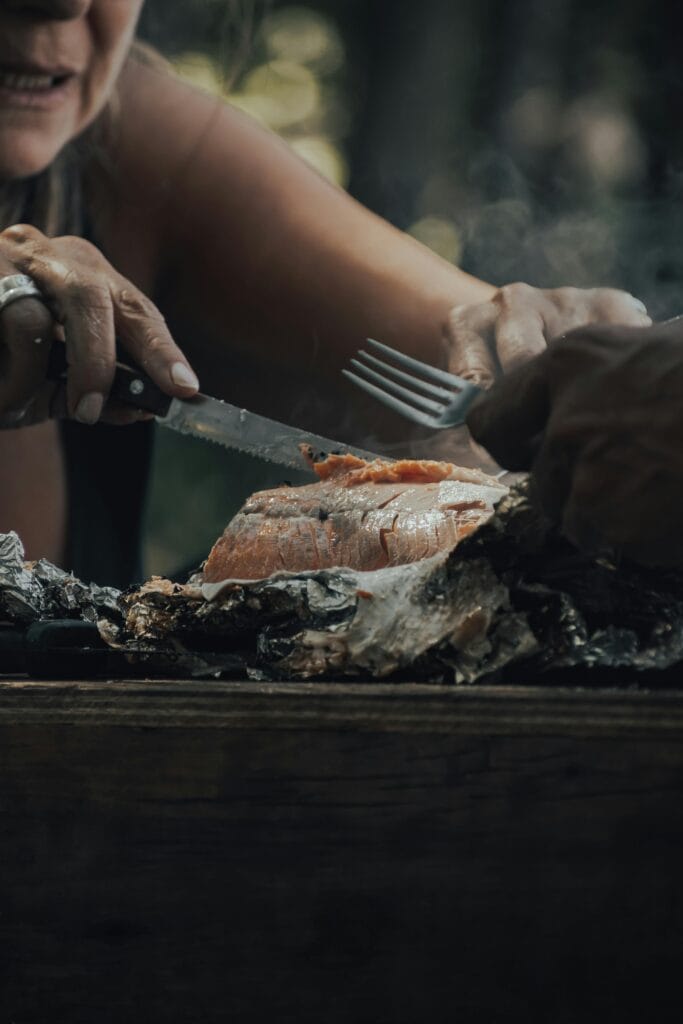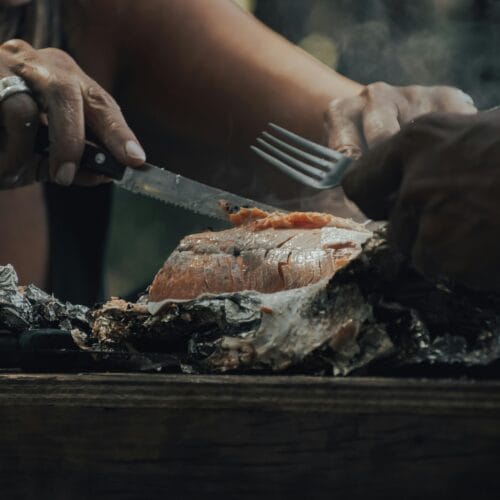smoked salmon internal temp
Smoking salmon is an art that needs precise temperature control. This balance is key for texture, flavor, and moisture. Knowing the internal temperature of smoked salmon is crucial for great taste.
Knowing the smoked salmon internal temp is crucial for great taste.
In this article, we’ll explore the science of smoked salmon doneness. We’ll look at what affects the ideal internal temperature and why controlling it is important. You’ll learn how to prepare, brine, and smoke salmon perfectly. Plus, how to use a meat thermometer to get the salmon just right.
By the end, you’ll know how to make delicious smoked salmon. It will impress your family and friends.
Key Takeaways
- The ideal internal temperature for smoked salmon is between 140°F and 160°F.
- Achieving the proper internal temp is crucial for a moist, flavorful, and food-safe smoked salmon.
- Understanding the factors that affect internal temperature, such as smoking method and salmon thickness, is key to mastering the smoking process.
- Using a reliable meat thermometer is essential for accurately monitoring the internal temperature of your smoked salmon.
- Proper resting and cooling of the smoked salmon helps maintain the ideal internal temperature and texture.
- Understanding the ideal smoked salmon internal temp is essential for achieving a perfectly cooked result.
Table of Contents
Understanding Smoked Salmon Doneness

Getting your smoked salmon just right is a fine art. The fish’s internal temperature is key, as it shows how cooked and moist it is. The type of smoker, how you smoke it, and the salmon cut all play a part in this.
Factors Affecting Internal Temperature
Several things can change the internal temperature of your smoked salmon:
- Smoker type: Electric, charcoal, or wood-fired smokers can produce different heat ranges and smoke densities.
- Smoking method: Hot smoking at higher temps vs. cold smoking at lower temps will affect the internal temp.
- Salmon cut: Thicker fillets or steaks will take longer to reach the desired smoked salmon doneness temperature.
- The fish’s smoked salmon internal temp is key, as it shows how cooked and moist it is.
Why Proper Temperature Matters
Keeping the right smoked salmon internal temp is key to preventing the fish from becoming dry, tough, or undercooked. It stops the fish from getting dry, tough, or undercooked. The best range for smoked salmon doneness is between 120°F and 140°F.
Below 120°F, it’s undercooked. Above 140°F, it gets dry and chalky. By knowing what affects the temperature and aiming for the perfect smoked salmon doneness, you’ll get moist, tasty salmon.
Preparing for the Smoking Process

Before you start smoking salmon, you need to prepare it right. This means picking the best salmon cut, cleaning it, and letting it brine or cure. Knowing these steps will help you succeed in smoking.
First, pick a high-quality salmon fillet or slab. It should be fresh, firm, and without any bad spots. Then, trim and clean the fish. Take off scales, bones, and extra fat or skin. This makes sure the smoke gets in evenly and cooks it right.
- Select a fresh, high-quality salmon fillet or slab.
- Trim and clean the salmon, removing scales, pin bones, and excess fat or skin.
- Prepare the salmon for brining or curing, as this will help enhance the flavor and texture of the final product.
Once the salmon is ready, it’s time to smoke it. Brining or curing the salmon is key. It makes the salmon taste better and feel softer. This step uses saltwater or dry salt to preserve the salmon and add flavor.
| Step | Description |
|---|---|
| Selecting the Salmon | Choose a fresh, high-quality salmon fillet or slab, free of any discoloration or blemishes. |
| Trimming and Cleaning | Remove scales, pin bones, and excess fat or skin to ensure even smoke penetration and cooking. |
| Brining or Curing | Soak the salmon in a saltwater solution or coat it with a dry salt mixture to enhance flavor and texture. |
By getting the salmon ready for smoking, you’re on your way to making perfect smoked salmon. It’s going to taste amazing!
Brining and Curing Salmon

Getting your salmon ready before smoking is key for the right texture and taste. Brining and dry curing are two main ways to do this. They help keep the fish moist and add a deep flavor.
Traditional Brine Recipes
A traditional brine for brining salmon for smoking is a saltwater mix, often with spices and herbs added. Here are some brine recipes you might like:
- Simple Salt Brine: Mix 1 cup of salt in 1 gallon of water. Soak the salmon for 2-4 hours.
- Brown Sugar Brine: Use 1 cup of brown sugar, 1/2 cup of salt, and 1 gallon of water. Brine for 4-8 hours.
- Dill Brine: Combine 1 cup of salt, 1/2 cup of brown sugar, 2 tablespoons of dried dill, and 1 gallon of water. Brine for 6-12 hours.
Dry Curing Methods
Curing salmon for smoking is another great method. Dry curing uses a salt, sugar, and spice mix to coat the salmon. It’s left to sit for hours or days. This method removes moisture and intensifies the flavor. Here’s a basic dry cure recipe:
- Blend 1/4 cup of salt, 2 tablespoons of brown sugar, and 1 teaspoon of black pepper.
- Evenly apply the cure mix to the salmon fillets.
- Put the salmon in the fridge and cure for 6-12 hours, flipping it a few times.
Whether you pick smoked salmon brine recipes or dry curing methods, the goal is to find what tastes best to you.
Choosing the Right Smoker
Choosing the right smoker is key when smoking salmon. The smoker type affects the internal temperature and the dish’s final taste. Hot smoking and cold smoking are the two main methods, each with its own temperature and time.
Understanding these differences helps you pick the best smoker. This ensures your smoked salmon reaches the perfect internal temperature.
Hot Smoking vs. Cold Smoking
Hot smoking and cold smoking are the two main types of smokers for salmon. Let’s look at their differences:
| Hot Smoking | Cold Smoking |
|---|---|
| Operates at temperatures between 225°F and 300°F | Operates at temperatures below 100°F, typically around 70-90°F |
| Cooks and smokes the salmon simultaneously, resulting in a fully cooked, flaky texture | Slowly infuses the salmon with smoke flavor without cooking it, leaving the texture raw or lightly cured |
| Requires less time, typically 2-6 hours | Requires a longer smoking time, often 12-24 hours or more |
| Produces a more pronounced smoky flavor | Produces a delicate, mellow smoky flavor |
When picking the right types of smokers for salmon, think about the internal temperature, texture, and flavor you want. Hot smoking vs cold smoking salmon gives different results. Choose wisely based on your preferences.
Smoking Techniques for Optimal Temperature
Getting the perfect smoked salmon internal temp is key when smoking salmon. Learning how to keep the temperature right can greatly improve your dish. Here are some important strategies to try:
- Monitor Temperature Closely – Always watch the temperature in your smoker. Adjust the airflow and smoke as needed to keep it just right.
- Utilize Proper Wood Selection – Pick the right wood chips or pellets for the best smoke and temperature control. Different woods can change how your salmon cooks.
- Manage Airflow Carefully – Change the smoker’s vents and dampers to control airflow. This is vital for keeping the temperature steady.
- Avoid Temperature Fluctuations – Sudden temperature changes can ruin the texture and taste of your salmon. Aim for a steady, even cooking process.
By using these techniques for smoking salmon and maintaining temperature, you’ll get the perfect internal temperature every time.
| Technique | Description |
|---|---|
| Temperature Monitoring | Regularly check the salmon’s internal temperature with a meat thermometer. This ensures it stays in the best range. |
| Wood Selection | Opt for hardwoods like maple, oak, or hickory. They burn slowly and evenly, giving a steady temperature and smoke. |
| Airflow Adjustment | Control the smoker’s vents and dampers to manage airflow. This keeps the temperature stable and smoke level consistent. |
| Temperature Consistency | Try to avoid sudden temperature changes. These can harm the texture and taste of your smoked salmon. |
“Maintaining the proper internal temperature is crucial for achieving the perfect texture and flavor in your smoked salmon.”
By following these techniques for smoking salmon and maintaining temperature, you’ll make delicious, perfectly cooked smoked salmon every time.
Smoked Salmon Internal Temp
Getting the right internal temperature is key when smoking salmon. It ensures the salmon is cooked well and tastes great. The best temperature for smoked salmon is between 125°F (52°C) and 140°F (60°C). This depends on the smoking method, the salmon cut, and how done you like it.
Recommended Temperature Range
The perfect internal temperature for smoked salmon can change based on your taste and the smoking method. Here are some general guidelines:
- Hot-smoked salmon: 135°F (57°C) to 140°F (60°C)
- Cold-smoked salmon: 125°F (52°C) to 130°F (54°C)
It’s important to check the ideal internal temp for smoked salmon to get it just right. If it’s not cooked enough, it’s soft and mushy. If it’s too cooked, it’s dry and tough. Keeping the recommended temperature range for smoked salmon helps you get the best flavor and texture.
| Smoking Method | Ideal Internal Temperature | Texture and Flavor |
|---|---|---|
| Hot Smoking | 135°F (57°C) to 140°F (60°C) | Firm, flaky texture with a pronounced smoked flavor |
| Cold Smoking | 125°F (52°C) to 130°F (54°C) | Delicate, silky texture with a subtle smoked taste |
“The key to perfectly smoked salmon is maintaining the recommended internal temperature range throughout the smoking process.”
Knowing the ideal internal temp for smoked salmon and the recommended temperature range helps you make perfect homemade smoked salmon every time.
Checking for Doneness
Knowing when your smoked salmon is done is key to a great dish. The best tool for this is a meat thermometer. It helps you keep an eye on the salmon’s temperature as it smokes.
Using a Meat Thermometer
To see if your smoked salmon is ready, just follow these steps:
- Put the meat thermometer into the thickest part of the salmon fillet, but skip the bones.
- Make sure the thermometer isn’t touching fat or the grill, as this can mess up the reading.
- Look at the salmon’s internal temperature. You want it between 145°F (63°C) and 160°F (71°C).
- If it’s not there yet, keep smoking until it hits the right spot.
Using a meat thermometer is the top way to check if smoked salmon is done. It helps you get perfect results every time. By using a meat thermometer for smoked salmon, you can make sure it’s always delicious.
| Doneness Level | Internal Temperature Range |
|---|---|
| Rare | 120°F (49°C) to 125°F (52°C) |
| Medium-Rare | 130°F (54°C) to 135°F (57°C) |
| Medium | 140°F (60°C) to 145°F (63°C) |
| Medium-Well | 150°F (66°C) to 155°F (68°C) |
| Well-Done | 160°F (71°C) and above |
“Using a meat thermometer is the best way to ensure your smoked salmon is cooked to perfection.”
Resting and Cooling the Smoked Salmon

After the resting smoked salmon reaches the right internal temperature, it needs to rest and cool. This step keeps the salmon moist and lets the flavors mature. Knowing how to do this right will make your smoked salmon perfect.
Start by letting the resting smoked salmon sit at room temperature for 10-15 minutes. This lets the juices spread evenly, making the salmon moist and tasty. Keep an eye on the temperature as it will still rise a bit.
After resting, it’s time to cool the smoked salmon. Put it on a wire rack or baking sheet and chill it for at least 30 minutes. This quick cooling keeps the smoky taste and prevents dryness.
If you’re saving the smoked salmon for later, wrap it tightly in plastic or foil and refrigerate. Proper resting smoked salmon and cooling smoked salmon ensures it stays great for days.
Delicious Smoked Salmon Dishes
Smoked salmon is a versatile ingredient that can make any dish special. It’s perfect for parties or adding elegance to home-cooked meals. Using your homemade smoked salmon in these recipes will surely impress everyone.
Smoked Salmon Appetizers
Begin your meal with these tasty smoked salmon appetizers. Amaze your guests with a smoked salmon and cream cheese canapé. Or, try a smoked salmon tartlet with fresh dill and lemon zest for a unique twist.
For something more elegant, make a smoked salmon roulade. Fill it with herbed cheese and serve it on a bed of mixed greens.
Smoked Salmon Main Courses
Take your dinner to the next level with smoked salmon main courses. Add flaked smoked salmon to a creamy pasta dish. Or, place it on a fresh salad with a tangy vinaigrette.
For a fancy main course, bake a salmon Wellington. It’s a savory smoked salmon wrapped in puff pastry.
| Smoked Salmon Appetizer | Smoked Salmon Main Course |
|---|---|
| Smoked Salmon and Cream Cheese Canapés | Smoked Salmon Pasta in a Lemon Cream Sauce |
| Smoked Salmon Tartlets with Dill and Lemon | Smoked Salmon Salad with Balsamic Vinaigrette |
| Smoked Salmon Roulade with Herbed Cheese | Smoked Salmon Wellington in Puff Pastry |
By using your perfectly smoked salmon in these dishes, you’ll impress your family and friends. Homemade smoked salmon adds a rich, smoky flavor that’s hard to beat.
Tips for Perfectly Smoked Salmon
Smoking salmon to perfection is an art that needs precision and care. Whether you’re experienced or new, these tips will help you make delicious smoked salmon. You’ll learn how to pick the right fish, control the temperature, and time it just right.
Start by choosing the freshest, highest-quality salmon. Look for fillets or steaks that are vibrant, firm, and have no bruises. This will make your smoked salmon taste amazing.
- Properly brine or dry-cure the salmon before smoking to enhance its texture and prevent it from drying out.
- Maintain a consistent temperature throughout the smoking process, ensuring the internal temperature of the salmon reaches the recommended range for optimal doneness.
- Patience is key – allow the salmon to rest and cool completely before slicing and serving to allow the flavors to meld.
Lastly, try different wood chips, seasonings, and smoking techniques to create your own style. The fun of smoked salmon is in the process of improving your skills, one tasty piece at a time.
“Smoking salmon is an art form that requires precision, patience, and a deep appreciation for the process. With these tips, you’ll be on your way to achieving perfectly smoked salmon every time.”
Conclusion
Understanding the smoked salmon internal temp is vital for crafting the perfect smoked salmon. Knowing the recommended temperatures, monitoring them closely, and using the right techniques are key for delicious results.
If you’re new to cooking or already skilled, this info will help you make amazing dishes. You now know how to get the salmon just right and how to smoke it perfectly. Use this knowledge to make your smoked salmon dishes even better.
Keep trying new things and improving your skills as you get better at smoking salmon. It can be the star of a big event or a simple, tasty meal. With what you’ve learned, you’re ready to create unforgettable moments with your smoked salmon.
With this knowledge of the ideal smoked salmon internal temp, you’re ready to create unforgettable moments with your smoked salmon.
FAQ
What is the ideal internal temperature for smoked salmon?
The perfect internal temperature for smoked salmon is between 135°F to 145°F (57°C to 63°C). This ensures it’s cooked right, stays moist, and tastes great.
How do I check the internal temperature of smoked salmon?
Use a meat thermometer to check the salmon’s internal temperature. Stick it into the thickest part, avoiding bones. Keep an eye on the temperature to hit the ideal range.
What factors affect the internal temperature of smoked salmon?
Several things can change the salmon’s internal temperature. These include the smoker type, smoking method, salmon cut, and smoking time. Brining or curing the salmon also plays a role.
What are the benefits of achieving the ideal internal temperature for smoked salmon?
The right internal temperature makes the salmon tender, moist, and flavorful. It ensures the salmon is cooked just right, with a delicate texture and smoky taste.
How do I prepare salmon for the smoking process?
Preparing the salmon is key. Choose the right cut, trim and clean it, and brine or cure it. These steps help keep the salmon moist and flavorful during smoking.
What are the differences between hot smoking and cold smoking salmon?
Hot smoking uses temperatures between 165°F to 225°F (74°C to 107°C), while cold smoking is at 75°F to 85°F (24°C to 29°C). Hot smoking is quicker, while cold smoking takes longer.
What are some tips for maintaining the ideal temperature when smoking salmon?
Keep the temperature right by monitoring it, adjusting airflow and smoke, and using the right wood. These tips will help you get the perfect temperature for your smoked salmon.
What are some delicious smoked salmon dishes I can make?
Smoked salmon is great in many dishes. Try it on bagels, in crostini, with pasta, or in salads. It’s a versatile ingredient for many tasty meals.
What is the significance of maintaining the correct smoked salmon internal temp?

Smoked Salmon Recipe
Ingredients
- 1 pound fresh salmon fillet skin on
- 1 cup kosher salt
- 1/2 cup brown sugar
- 1 tablespoon black pepper
- Optional: herbs like dill or thyme, garlic, lemon zest for added flavor
Instructions
- Prepare the Brine:
- In a bowl, mix together the kosher salt, brown sugar, and black pepper.
- If desired, add herbs, minced garlic, or lemon zest for extra flavor.
- Brine the Salmon:
- Coat the salmon fillet with the brine mixture, ensuring it’s evenly covered.
- Place the salmon in a sealable plastic bag or a shallow dish, and refrigerate for 4-8 hours.
- Rinse and Dry:
- After brining, rinse the salmon under cold water to remove excess salt.
- Pat it dry with paper towels and place it on a wire rack to air dry for 1-2 hours. This helps form a pellicle, which is essential for smoke adherence.
- Prepare the Smoker:
- Preheat your smoker to the desired temperature (between 225°F and 300°F for hot smoking; around 70-90°F for cold smoking).
- Choose your wood chips (like hickory, apple, or maple) for flavor.
- Smoke the Salmon:
- Place the salmon in the smoker, skin-side down.
- For hot smoking, smoke for 2-6 hours, or until the internal temperature reaches 135°F to 140°F.
- For cold smoking, allow it to smoke for 12-24 hours, monitoring the internal temperature to reach 125°F to 130°F.
- Rest and Cool:
- Once done, remove the salmon from the smoker and let it rest at room temperature for 10-15 minutes.
- Cool it in the refrigerator for at least 30 minutes before slicing.
Notes
- Experiment with different brine flavors and wood types for a unique taste.
- For storage, wrap the smoked salmon tightly in plastic wrap or foil and refrigerate. It can last for up to a week.

